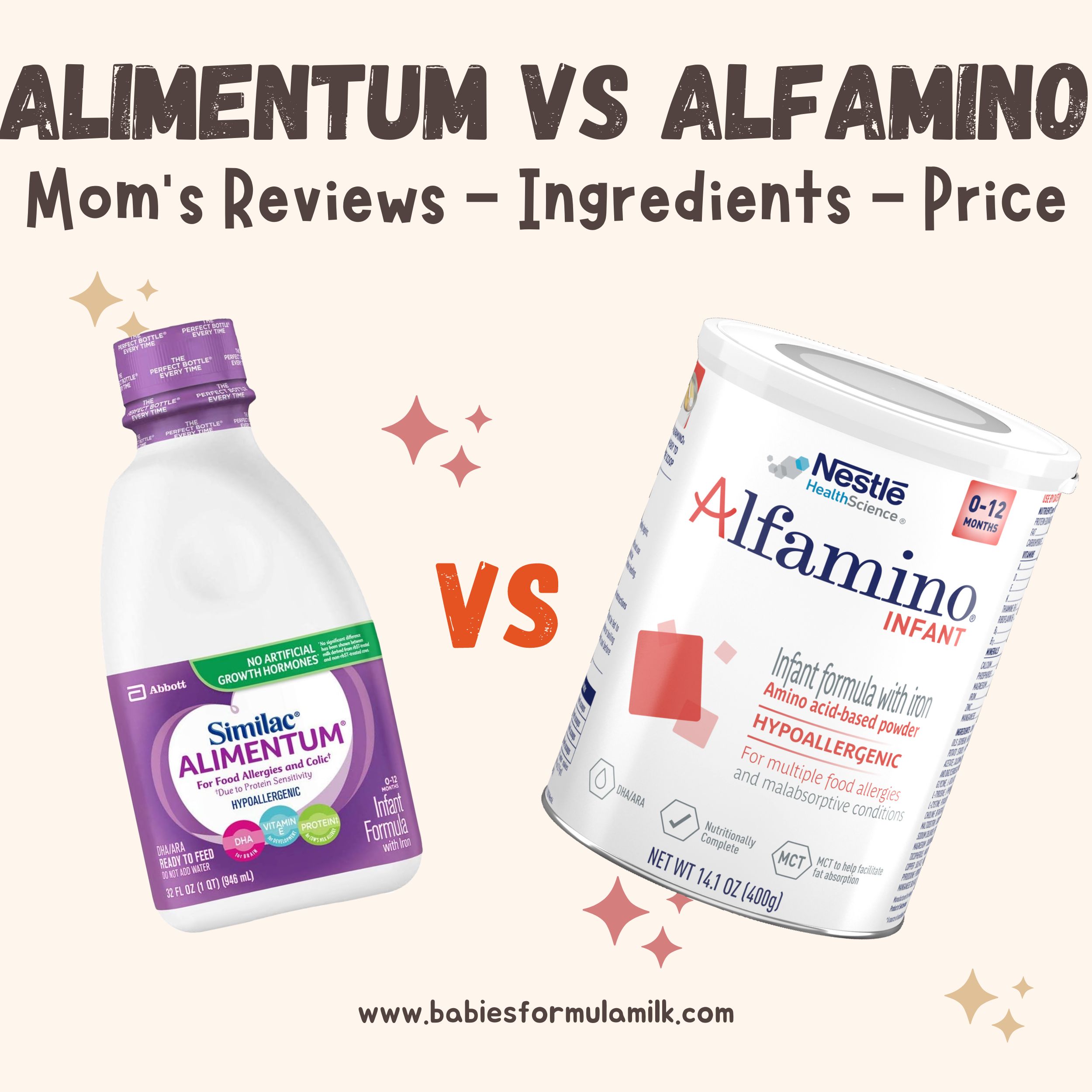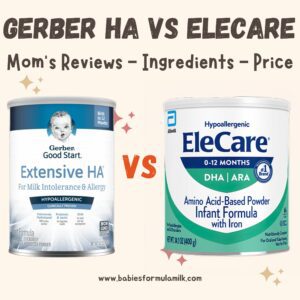Key Differences:
Alimentum RTF and Alfamino are both hypoallergenic infant formulas designed for babies with cow’s milk or soy milk allergies. Alimentum RTF (Ready-to-Feed) is an extensively hydrolyzed formula, suitable for mild to moderate allergies, as it breaks down proteins for easier digestion. On the other hand, Alfamino is an amino acid-based formula, containing no intact proteins, making it ideal for babies with severe allergies who cannot tolerate extensively hydrolyzed formulas. Both formulas provide a safe and complete alternative to regular cow’s milk or soy milk-based formulas.
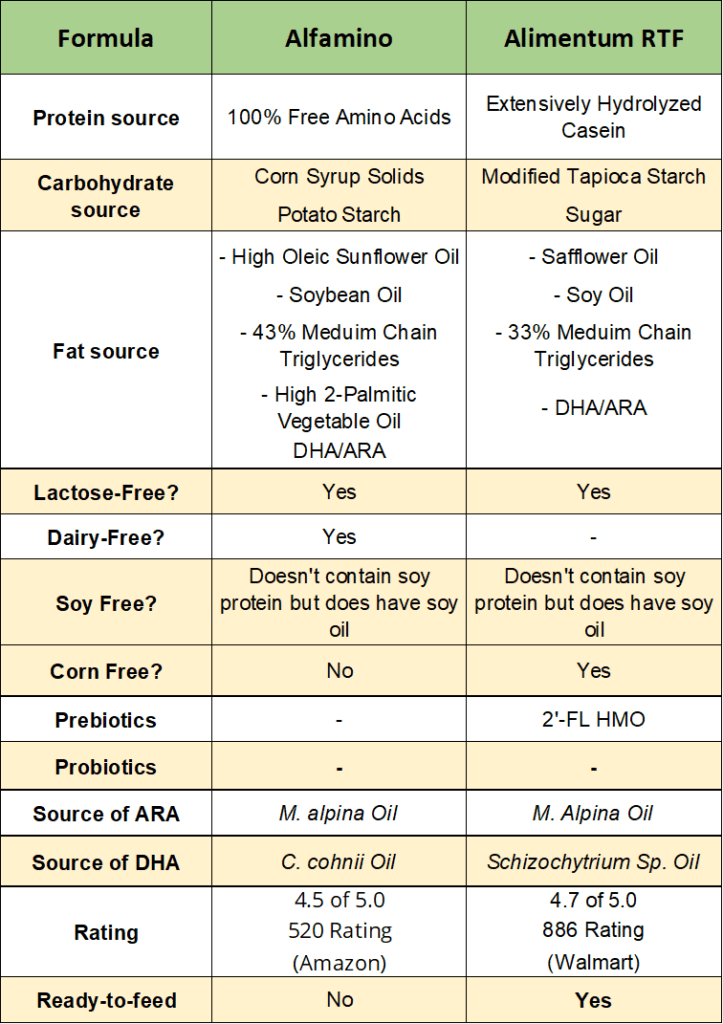
Cow’s milk and soy milk allergies are common food allergies, particularly among infants and young children. These allergies occur when the immune system mistakenly identifies proteins in cow’s milk or soy milk as harmful, leading to various allergic reactions. Symptoms can range from mild skin irritations to more severe respiratory issues or anaphylaxis.
To address this, hypoallergenic formulas have been developed. These formulas are designed to minimize the risk of triggering allergic reactions and are often based on extensively hydrolyzed proteins or amino acids.
Extensively hydrolyzed formulas break down proteins into smaller fragments, making them less likely to cause allergies. Amino acid-based formulas, on the other hand, contain no intact protein, making them suitable for babies with severe allergies. Hypoallergenic formulas offer a safe and nutritionally complete alternative for babies who cannot consume regular cow’s milk or soy milk-based formulas due to allergies.
The Best One?
The choice between Alimentum and Alfamino depends on your baby’s specific needs and health concerns.
Alimentum ready-to-feed is ideal for mild to moderate allergies, addressing issues like gas, spit-up, colic, and fussiness. It is a cost-effective option for babies with cow’s milk or lactose allergies, making it a recommended initial choice over Alfamino.
Also, it’s recommended for babies with corn allergies because it’s corn-free.
On the other hand, Alfamino is specially formulated for infants with severe allergies or adverse reactions to extensively hydrolyzed formulas. It has been shown to effectively manage problems like reflux, tummy issues, and weight gain difficulties. However, due to its higher cost, it is generally considered the last option to consider.
Also, take into consideration that every baby is different and what works for other babies doesn’t necessarily work for your LO.
Mom’s Reviews Comparison:

According to moms, Alimentum RTF has shown good results in relieving gas, spit-up, colic, and fussiness due to cow’s milk, lactose, and corn allergy because Alimentum RTF is corn free which is a plus for this formula. Furthermore, it’s premade which makes it easy to use for busy moms and during the night.
However, moms were mad about the price because it was increased two times, now at Walmart the price is 13.12$ for a 32oz bottle, but the insurance can cover it, to do so, your doctor must provide :
- a signed letter stating the condition it’s needed for
- a copy of the diagnosis in the baby’s chart
- a copy of the prescription.
To see if your insurance will cover it, visit this website.
Also, Alimentum RTF is hard to travel with as it needs to be refrigerated and is only good for 48 hours after opening. But, some moms suggest buying the 2 oz bottles and keeping an empty bottle in your diaper bag.
Another complaint is the bottle pouring design, the formula always drips down the side of the bottle which is frustrating.
Moreover, since it’s premade you can’t control the consistency and many moms said that it has a thick consistency.
On the other hand, Alfamino shows good results in relieving reflux and tummy problems that extensively hydrolyzed formula can’t handle, also many moms claimed that their baby has gained weight fastly when switching to this formula.
However, many moms complain about the price and availability, it’s way expensive and hard to find in stores. Also, it does not fully dissolve in water, and the grainy texture that’s left over can clog the nipple of the bottle. To solve this issue, some moms recommend Dr. Brown’s.
Related: Alimentum RTF Vs EleCare: Which one is The Best (With Charts)
Ingredients Comparison:
Protein Source:
The main difference between Alimentum RTF and Alfamino lies in their protein sources.
Alimentum RTF (Ready-to-Feed) is an extensively hydrolyzed formula, which means that the proteins found in cow’s milk or soy milk are broken down into smaller fragments. This process makes the proteins easier to digest and reduces the risk of triggering allergic reactions in babies with cow’s milk or soy milk allergies.
On the other hand, Alfamino is an amino acid-based formula. Unlike Alimentum RTF, it does not contain any intact proteins from cow’s milk or soy milk. Instead, the formula is made from individual amino acids, which are the building blocks of proteins. This makes Alfamino a suitable option for babies with severe allergies who cannot tolerate even the hydrolyzed proteins found in Alimentum RTF.
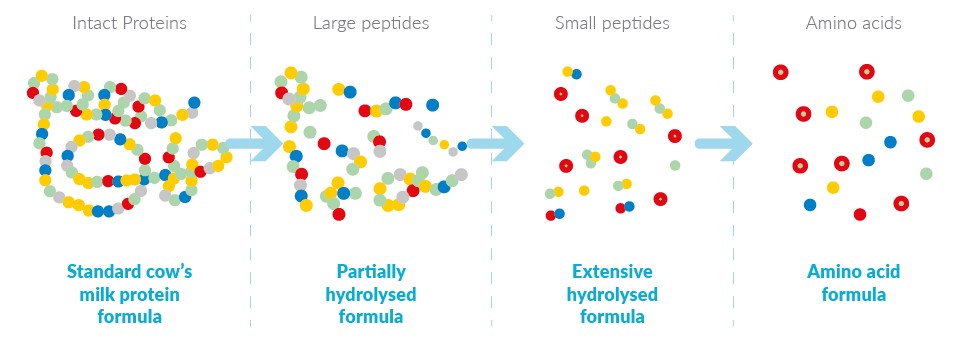
Carbohydrate Source:
The carbohydrate sources in Alimentum RTF and Puramino differ, catering to babies with different dietary requirements.
Alimentum RTF uses modified tapioca starch and sugar as its carbohydrate sources. Modified tapioca starch is a modified form of tapioca starch that provides a source of carbohydrates. The addition of sugar helps to provide energy and enhance the taste of the formula.
If you have problems with the existence of sugar in baby formula, look for Nutramigen it’s sugar-free. I did a full comparison between Nutramigen and Alimentum if you want to check.
On the other hand, Puramino uses corn syrup solids and potato starch as its carbohydrate sources. Corn syrup solids are derived from corn and serve as a source of easily digestible carbohydrates, while potato starch also contributes to the carbohydrate content of the formula.
The starch in the baby formula may also act as a thickener agent. That’s why moms said that Alimentum’s consistency is thick.
Fat Source:
In terms of fat sources, Alimentum RTF contains safflower oil, soy oil, medium-chain triglycerides (MCTs), and DHA/ARA (docosahexaenoic acid/arachidonic acid). Safflower oil and soy oil provide essential fatty acids, while MCTs are easily digestible fats that can be helpful for babies with certain digestive issues. DHA and ARA are important omega-3 and omega-6 fatty acids, respectively, that support brain and eye development.
In contrast, Alfamino uses high oleic sunflower oil, soybean oil, medium-chain triglycerides (MCTs), high 2-palmitic vegetable oil, and DHA/ARA. High oleic sunflower oil and soybean oil are rich sources of essential fatty acids, while MCTs are included for ease of digestion. High 2-palmitic vegetable oil is used to mimic the fat composition found in breast milk, which can be beneficial for some babies with specific feeding challenges.
MCTs make 43% of the fat in Alfamino while it makes 33% of Alimentum’s fat.
Related: Alimentum RTF Vs Neocate: Full Comparison (With Charts)
Prebiotics:
Regarding prebiotics, Alfamino doesn’t have one whereas Alimentum RTF has the 2′-Fucosyllactose (2FL) which is a type of human milk oligosaccharide (HMO).
HMOs are non-digestible compounds that serve as prebiotics, meaning they promote the growth and activity of beneficial bacteria in the infant’s gut. These beneficial bacteria, also known as probiotics, play a crucial role in supporting a healthy gut microbiome, which is essential for overall digestive and immune system development.
The presence of 2′-Fucosyllactose in Alimentum RTF helps to mimic some of the benefits of breast milk, even for babies with cow’s milk or soy milk allergies who cannot be exclusively breastfed.
Nutrition Comparison:

Macronutrients:
In terms of macronutrients, Alimentum RTF has high levels of fat than Alfamino while this last has high levels of protein and carbohydrate.
Vitamins:
In terms of vitamins, Alimentum RTF and Alfamino provide different nutrient profiles to meet the unique nutritional needs of infants with specific dietary requirements.
Alimentum RTF contains higher levels of vitamins E, K, B12, niacin, pantothenic acid, and biotin. These vitamins play essential roles in various bodily functions, such as supporting the immune system (vitamin E), blood clotting (vitamin K), and energy metabolism (B vitamins).
On the other hand, Alfamino is characterized by higher levels of vitamins A, D, C, B1, B2, B6, choline, and inositol. Vitamin A is crucial for vision and immune function, vitamin D is essential for bone health and calcium absorption, and vitamin C supports the immune system and acts as an antioxidant. B vitamins (B1, B2, and B6) are essential for energy production and nervous system function, while choline and inositol play roles in brain development and overall cellular health.
The variation in vitamin content between Alimentum RTF and Alfamino is intended to provide specific nutritional support for infants with different dietary sensitivities and nutritional needs.
Minerals:
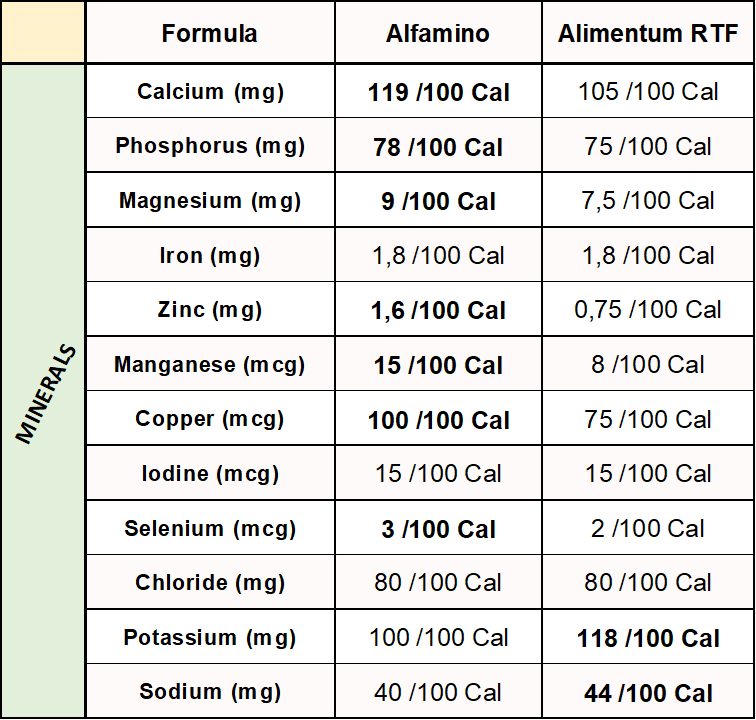
When comparing Alimentum RTF and Alfamino in terms of minerals, they offer different nutrient compositions to address the specific nutritional needs of infants with different dietary sensitivities.
Alimentum RTF contains higher levels of potassium and sodium. Potassium is an essential mineral that plays a role in maintaining proper nerve function and supporting heart health. Sodium is important for maintaining fluid balance and nerve function.
On the other hand, Alfamino is characterized by higher levels of calcium, phosphorus, magnesium, zinc, manganese, copper, and selenium. These minerals are vital for various aspects of growth and development. Calcium and phosphorus work together to support bone health and development. Magnesium is essential for muscle and nerve function, while zinc is crucial for immune function and overall growth. Manganese and copper are trace minerals involved in antioxidant function and metabolism, while selenium is essential for supporting the body’s antioxidant defense system.
Price and Size Comparison:
| ALIMENTUM | ALFAMINO |
|---|---|
| 34.84 $ 12.1 oz 2.88 /oz Buy HERE | 48.56 $ 14.1 oz 3.44 /oz Buy HERE |
| 12.79 $ 32 fl oz 40 ¢/fl oz Buy HERE at Walgreens 13.12 $ 32 fl oz 41 ¢/fl oz Buy HERE at Walmart | – |
Alfamino’s higher price compared to Alimentum can be attributed to several factors. Firstly, Alfamino’s formulation is more complex, as it aims to closely mimic the nutritional composition of breast milk. This complexity may involve using multiple sources of fats and carbohydrates, along with specific nutrients, which can increase production costs.
Furthermore, market demand plays a role in pricing. If Alfamino caters to a niche market with specific needs, its price may reflect the value it provides to those consumers.
Lastly, strict regulations and quality standards governing infant formulas can lead to increased manufacturing costs, which are also reflected in the final retail price.
How to Switch From Alimentum to Alfamino?
Transitioning from Alimentum to Alfamino should be a gradual process, supervised by a pediatrician. Here’s a step-by-step guide to help with the transition:
- Consult with a Pediatrician: Before making any changes to your baby’s formula, discuss the switch with your pediatrician. They can assess your baby’s specific dietary needs and recommend the appropriate timing and method for transitioning.
- Start Slowly: Begin the transition gradually by mixing the two formulas. For the first few days, mix a small amount of Alfamino with the current Alimentum formula. Gradually increase the ratio of Alfamino to Alimentum over several days.
- Observe for Allergic Reactions: During the transition, closely observe your baby for any signs of allergic reactions or intolerance to the new formula. In case of any negative reactions, promptly consult your pediatrician.
- Monitor Stool Changes: Be attentive to any changes in your baby’s stool pattern during the transition. Some changes in stool consistency and color are normal during a formula switch, but if you have concerns, consult your pediatrician.
- Complete the Transition: Continue increasing the proportion of Alfamino while reducing Alimentum until your baby is exclusively on Alfamino. The entire transition period may take around one to two weeks, depending on your baby’s tolerance and response to the new formula.
- Follow Mixing Instructions: If you are using powdered formula, follow the mixing instructions on the packaging carefully to ensure accurate preparation.
- Be Patient: Every baby is different, and some may adapt to a formula switch more easily than others. Be patient during the transition and provide extra care and attention to your baby’s well-being.
To ensure you make the best decision for your baby, always consult with your pediatrician or healthcare professional. They can provide personalized advice and guidance based on your baby’s health and condition, helping you choose the most suitable formula.

